Around the world, countless bird species are fighting for survival, facing challenges ranging from habitat loss and climate change to illegal hunting and competition with invasive species. The following list highlights 42 of the rarest birds that, despite their critically low populations, can still be found in the wild – if you’re lucky enough to spot them.
Sociable lapwing (Vanellus gregarius)
- Conservation status: Critically endangered.
- Estimated population: Between 10,000 and 12,000 mature individuals
- Habitat and distribution: Grasslands of Central Asia, migrating to parts of the Middle East, Northeast Africa, and the Indian subcontinent during winter.
- Threats: Habitat destruction and hunting along migration routes.
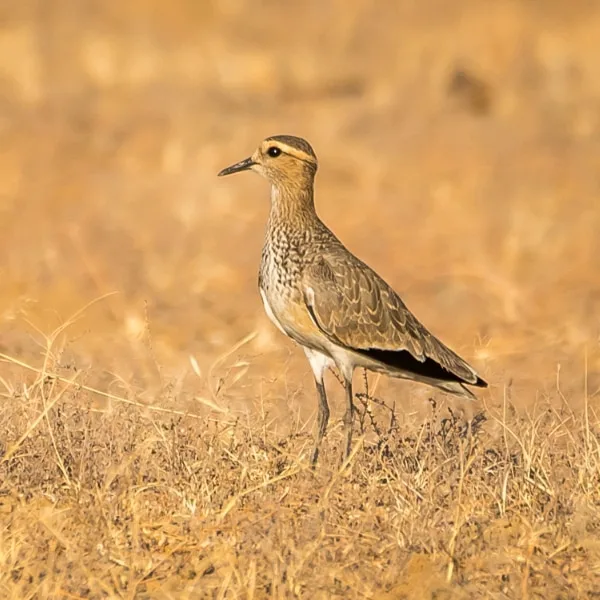
The sociable lapwing is a migratory bird that travels great distances across Central Asia to wintering sites in the Middle East, Africa, and India. With a population estimated between 10,000 and 12,000 mature individuals, this species has seen a severe decline due to habitat loss and hunting along its migration routes. Conservationists have implemented a Single Species Action Plan, aimed at restoring the population and reducing hunting threats.
The lapwing spends about a third of the year on its breeding grounds, a third on wintering grounds, and a third migrating between the two, exhibiting high fidelity to migration and winter sites but lower fidelity to breeding sites. International cooperation is crucial for protecting this species throughout its migratory path.
Red-headed vulture (Sarcogyps calvus)
- Conservation status: Critically endangered.
- Estimated population: Between 2,500 and 10,000 mature individuals.
- Habitat and distribution: Scattered across South Asia, particularly in India, and in some regions of Southeast Asia.
- Threats: Poisoning, habitat loss, and decline in food sources.
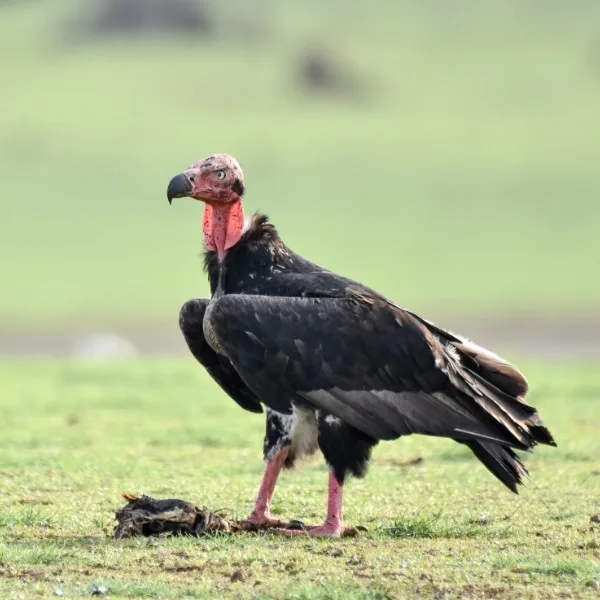
The red-headed vulture, once widespread in the Indian subcontinent, has seen its numbers dwindle due to accidental poisoning from consuming carcasses laced with toxic veterinary drugs like diclofenac. Habitat destruction and competition for dwindling food sources have only intensified these threats. Conservationists in India and surrounding areas have worked to raise awareness, remove toxic substances, and set up monitored breeding programs.
This vulture is a crucial player in its ecosystem, helping control disease by consuming carrion, which makes its decline a pressing environmental concern. Protection of its natural habitats, banning harmful drugs, and stricter controls on toxins are crucial to reversing the decline.
Christmas Island frigatebird (Fregata andrewsi)
- Conservation status: Critically endangered.
- Estimated population: Between 3,600 and 7,200 individuals; around 1,200 breeding pairs.
- Habitat and distribution: Exclusively breeds on Christmas Island in the Indian Ocean.
- Threats: Habitat loss due to phosphate mining, predation by invasive species, and disruption from yellow crazy ants.
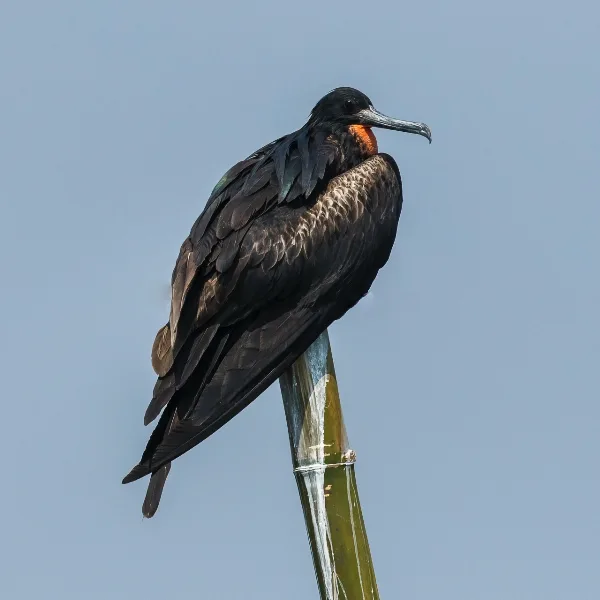
Found only on Christmas Island, the Christmas Island frigatebird faces significant threats due to habitat loss from phosphate mining and the impact of invasive yellow crazy ants, which disturb nesting sites and reduce breeding success.
Conservationists have focused efforts on habitat protection, ant population control, and restoring suitable nesting areas to secure the frigatebird’s future. Despite these efforts, the species remains critically endangered, as its restricted range and specific breeding requirements make it highly susceptible to environmental changes on the island.
Northern bald ibis (Geronticus eremita)
- Conservation status: Critically endangered.
- Estimated population: Around 1,000 individuals, including wild and reintroduced populations.
- Habitat and distribution: Small populations in Morocco, with reintroduction programs in Europe
- Threats: Habitat loss, hunting, and environmental changes.
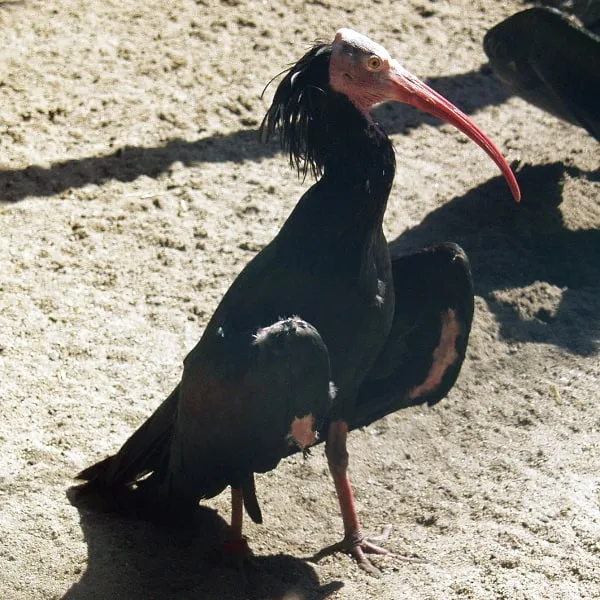
The northern bald ibis has faced severe population declines over the past century due to habitat loss, hunting, and environmental changes. However, intensive conservation efforts have resulted in significant successes. European reintroduction programs have established a new migratory population of about 200 individuals, and over 250 young birds have been raised in the wild since 2011.
A milestone was achieved in 2024 when conservationists led juvenile ibises in a human-guided migration to Andalusia, Spain, creating a new migration corridor that strengthens their survival prospects. Despite these advancements, ongoing efforts remain essential to secure the species’ future.
Millerbird (Acrocephalus familiaris)
- Conservation status: Endangered.
- Estimated population: Approximately 800 individuals.
- Habitat and distribution: Found on Nihoa and reintroduced to Laysan Island in Hawaii, where it inhabits dense, shrubby vegetation.
- Threats: Habitat loss due to invasive species, climate change, and predation by introduced animals.

The millerbird, a small, gray-brown songbird endemic to the Hawaiian Islands, once faced extinction after habitat loss caused the Laysan population to vanish.
In a significant conservation effort, conservationists successfully translocated individuals from Nihoa to Laysan in 2011 and 2012 to establish a second population. This reintroduction was crucial in stabilizing the species, leading to its downlisting from Critically Endangered to Endangered in 2023.
Ongoing monitoring and habitat management remain essential to secure the species’ future, as it is still highly vulnerable to environmental changes and invasive species.
White-shouldered ibis (Pseudibis davisoni)
- Conservation status: Critically endangered.
- Estimated population: Approximately 670 mature individuals (mostly in Cambodia)
- Habitat and distribution: Wetlands and grasslands in Cambodia, Laos, and Vietnam.
- Threats: Habitat loss due to agriculture, hunting, and human disturbance.
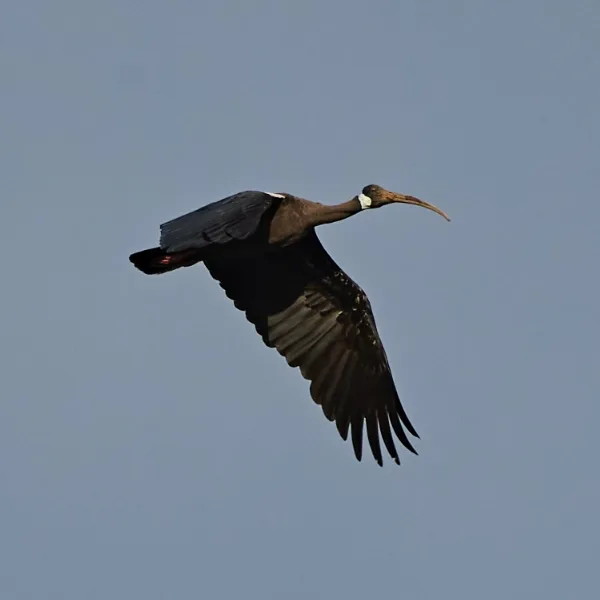
The white-shouldered ibis is a critically endangered species primarily found in Cambodia, which supports nearly 95% of the global population. As of 2025, a national census recorded approximately 670 mature individuals in Cambodia, underscoring the country’s crucial role in the species’ survival.
Conservation efforts, led by the Cambodia Ibis Working Group, have yielded remarkable achievements, including the first successful captive breeding and increased nest success rates. Despite these gains, the ibis remains vulnerable to habitat loss and hunting pressures. Ongoing initiatives focus on habitat preservation, field monitoring, and community engagement to secure the species’ future.
Saint Helena plover (Anarhynchus sanctaehelenae)
- Conservation status: Vulnerable.
- Estimated population: Approximately 600 mature individuals.
- Habitat and distribution: Restricted to the island of Saint Helena, primarily in flat, open upland areas.
- Threats: Habitat loss, predation by introduced species, human disturbance, and infrastructure development.
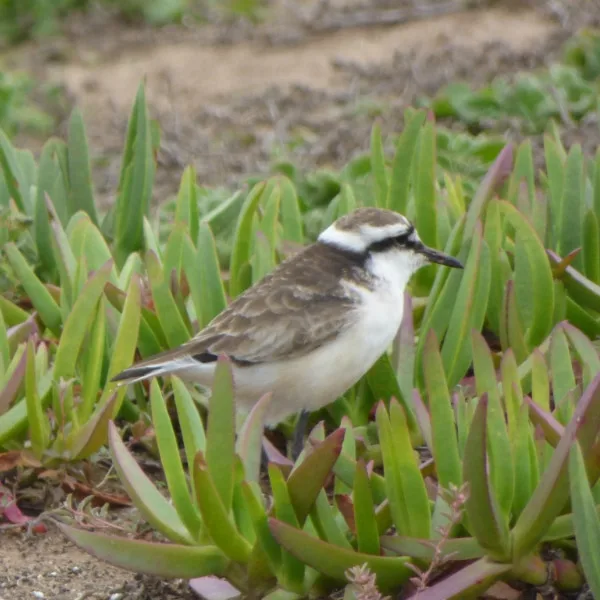
The Saint Helena plover, known locally as the wirebird due to its slender legs, is the only surviving endemic bird species on Saint Helena. Once classified as Critically Endangered, its population dwindled to fewer than 200 individuals in 2006 due to habitat loss and predation by invasive species, such as cats and the common myna. However, conservation initiatives led by the Saint Helena National Trust and the Royal Society for the Protection of Birds (RSPB) have improved the species’ status.
By 2016, the population rebounded to around 560 mature individuals, resulting in its reclassification to Vulnerable on the IUCN Red List. Current conservation projects focus on habitat management, monitoring, and integrating climate resilience measures to support the plover’s long-term survival.
Flores hawk-eagle (Nisaetus floris)
- Conservation status: Critically endangered.
- Estimated population: Between 320 and 1,500 mature individuals.
- Habitat and distribution: Found on the Indonesian islands of Flores, Lombok, Sumbawa, Komodo, and Alor, primarily in lowland and submontane forests.
- Threats: Deforestation, hunting, and capture for the pet trade, as well as persecution due to poultry predation.
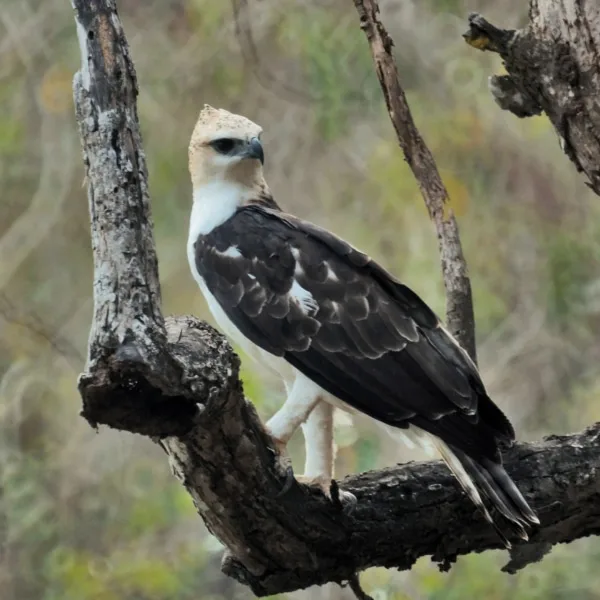
The Flores hawk-eagle is an endangered raptor species native to Indonesia’s Lesser Sunda Islands. With its population estimated between 320 and 1,500 mature individuals, this eagle is at high risk of extinction due to deforestation and hunting pressures.
Conservationists have initiated efforts to protect remaining forest habitats, implement local education programs, and promote coexistence with local communities. These measures aim to reduce hunting and capture for the pet trade, which significantly threaten the species. Continued conservation efforts are critical to preserve this eagle’s natural environment and promote its long-term survival.
Javan hawk-eagle (Nisaetus bartelsi)
- Conservation status: Endangered.
- Estimated population: Approximately 511 mature pairs as of 2023.
- Habitat and distribution: Forested mountainous regions in Java, Indonesia.
- Threats: Habitat loss due to deforestation, illegal pet trade, and human disturbance affecting nesting success.
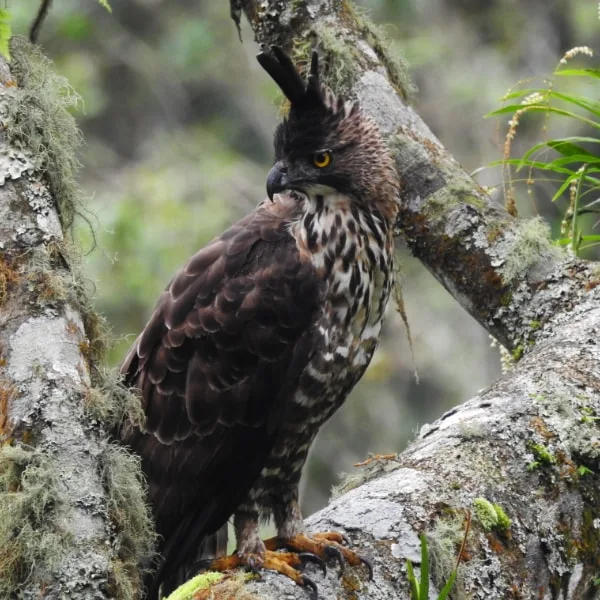
The Javan hawk-eagle, known locally as the Garuda, is a majestic raptor endemic to the island of Java, Indonesia. Recognized for its striking crest and distinctive plumage, it holds the esteemed position of being Indonesia’s national bird. With an estimated population of around 511 mature pairs, the species faces significant threats primarily due to habitat loss from deforestation for agriculture and urban development.
Illegal capture for the pet trade further exacerbates its decline, as these eagles are highly prized. Human disturbances near nesting sites also negatively impact breeding success.
Conservation efforts are focused on habitat preservation, including reforestation projects and the establishment of protected areas. Public awareness campaigns are crucial to reduce demand in the illegal pet trade and to educate local communities about the importance of conserving this national symbol.
The Javan hawk-eagle is legally protected under Indonesian law, and international trade is regulated by CITES. Ongoing research and monitoring aim to better understand the species’ ecology and inform effective conservation strategies.
Palila (Loxioides bailleui)
- Conservation status: Critically endangered.
- Estimated population: Approximately 680 mature individuals as of 2021.
- Habitat and distribution: Endemic to the upper slopes of Mauna Kea Volcano on Hawai‘i Island
- Threats: Habitat degradation by feral ungulates, predation by introduced species, and invasive plants.
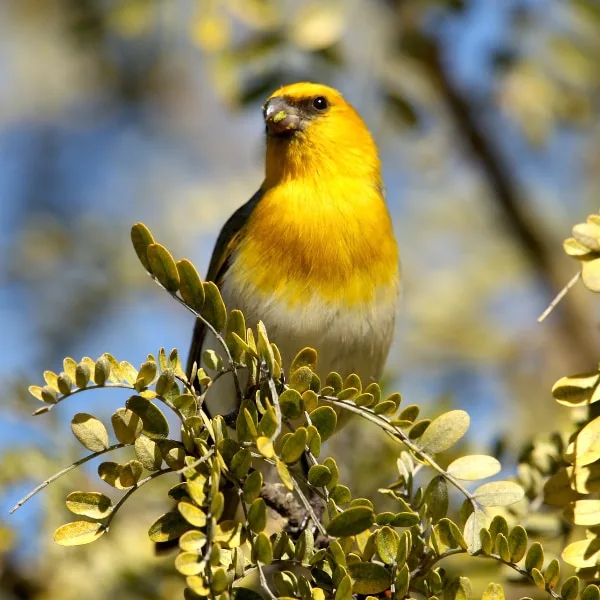
The palila is a super rare Hawaiian honeycreeper found exclusively on the upper slopes of Mauna Kea Volcano on Hawai‘i Island. This species relies heavily on mamane (Sophora chrysophylla) forests for food and nesting. The population has experienced a significant decline, with an estimated 89% decrease over a 23-year period, averaging a loss of 229 birds per year. As of 2021, the population was estimated at approximately 680 mature individuals.
Major threats to the palila include habitat degradation caused by feral ungulates such as sheep and goats, which impede Sophora chrysophylla regeneration. Predation by introduced species like feral cats and black rats poses additional risks. Invasive plants, particularly fire-prone grasses, further degrade the habitat and increase the risk of wildfires.
Conservation efforts focus on habitat restoration, including the removal of feral ungulates to promote mamane forest recovery. Predator control programs aim to reduce the impact of introduced predators. Ongoing research and monitoring are essential to inform conservation strategies and track population trends.
Laysan duck (Anas laysanensis)
- Conservation status: Critically endangered.
- Estimated population: Approximately 500-680 mature individuals.
- Habitat and distribution: Endemic to the Hawaiian Islands, primarily on Laysan Island and Midway Atoll.
- Threats: Habitat loss, invasive species, and environmental catastrophes.
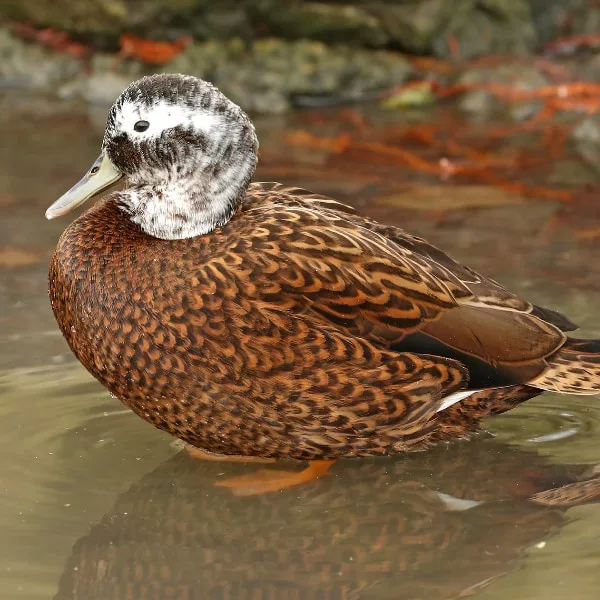
The Laysan duck, also known as the Laysan teal, is a small, dark brown duck endemic to the Hawaiian Islands. Historically widespread across the archipelago, its range has significantly contracted, now primarily inhabiting Laysan Island and Midway Atoll. The current population is estimated between 500 and 680 mature individuals, with an increasing trend.
This species prefers low-lying, vegetated areas near freshwater sources, such as ponds and marshes, where it forages for insects, seeds, and aquatic invertebrates.
Major threats to the Laysan duck include habitat loss due to environmental changes, the introduction of invasive species like rats and mosquitoes, and environmental catastrophes such as droughts and storms. For instance, the 2011 tsunami inundated parts of Midway Atoll, impacting the duck’s habitat.
Conservation efforts have been implemented to protect and support the population:
- Translocation projects: To reduce extinction risk, individuals have been translocated to predator-free islands, such as Midway Atoll, to establish additional populations.
- Habitat restoration: Efforts are underway to restore and maintain wetland habitats, ensuring the availability of food and nesting sites.
- Invasive species control: Programs aimed at eradicating or controlling invasive predators and competitors have been initiated to protect nests and increase survival rates.
Forest owlet (Athene blewitti)
- Conservation status: Critically endangered.
- Estimated population: Between 300 and 1,000 individuals.
- Habitat and distribution: Dry deciduous forests in central India, specifically in Maharashtra, Madhya Pradesh, and Odisha.
- Threats: Habitat loss, deforestation, and human disturbance.
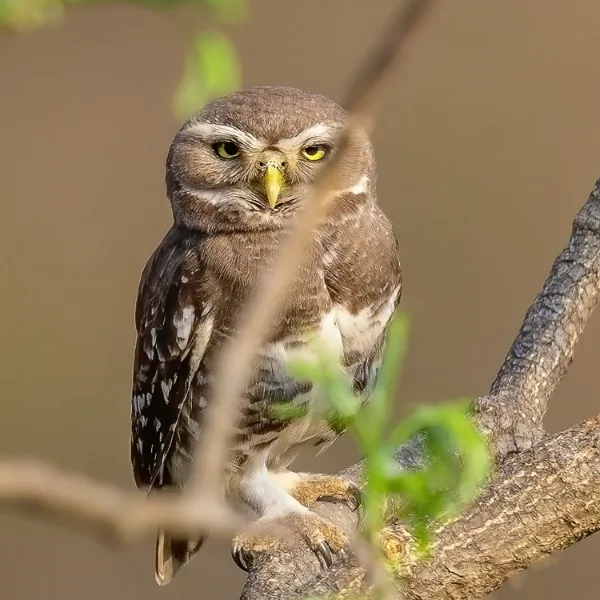
The forest owlet, once considered extinct for over a century, was rediscovered in 1997 in the forests of central India. With an estimated population of over 250 mature individuals, this species remains highly vulnerable due to ongoing habitat loss from deforestation and agricultural expansion.
Conservation efforts focus on habitat protection and stringent anti-poaching measures, as well as engagement with local communities to reduce human disturbances. The rediscovery of the forest owlet highlights the importance of field surveys and habitat preservation in conserving India’s unique avian diversity.
Blue-bearded helmetcrest (Oxypogon cyanolaemus)
- Conservation status: Endangered.
- Estimated population: Between 250 and 1,000 individuals.
- Habitat and distribution: Endemic to the Sierra Nevada de Santa Marta, Colombia.
- Threats: Habitat loss due to agriculture, fires, and grazing.

The blue-bearded helmetcrest is a rare hummingbird species found only in the high-altitude páramo ecosystems of the Sierra Nevada de Santa Marta in Colombia. After being unobserved for nearly 70 years and feared extinct, it was rediscovered in 2015. The species thrives in treeless, shrub-dominated páramo habitats at elevations between 3,200 and 4,800 meters.
Major threats to the blue-bearded helmetcrest include habitat loss from agricultural expansion, frequent fires (both natural and human-induced), and grazing by livestock, which degrade the delicate páramo environment. The bird’s specialized habitat requirements and limited range make it particularly vulnerable to these threats.
Conservation efforts are focused on habitat protection and restoration. While the Sierra Nevada de Santa Marta is a designated national park, enforcement of conservation measures can be challenging. Environmental organizations are working to raise awareness and promote sustainable land-use practices among local communities to preserve the remaining habitat of this unique hummingbird.
Cone-billed tanager (Conothraupis mesoleuca)
- Conservation status: Endangered.
- Estimated population: Between 250 and 990 mature individuals.
- Habitat and distribution: Found in gallery forests and flooded areas within the Cerrado biome in Brazil, especially along the upper Juruena River and in Emas National Park.
- Threats: Habitat loss due to agricultural expansion, and potential habitat flooding from hydroelectric projects.
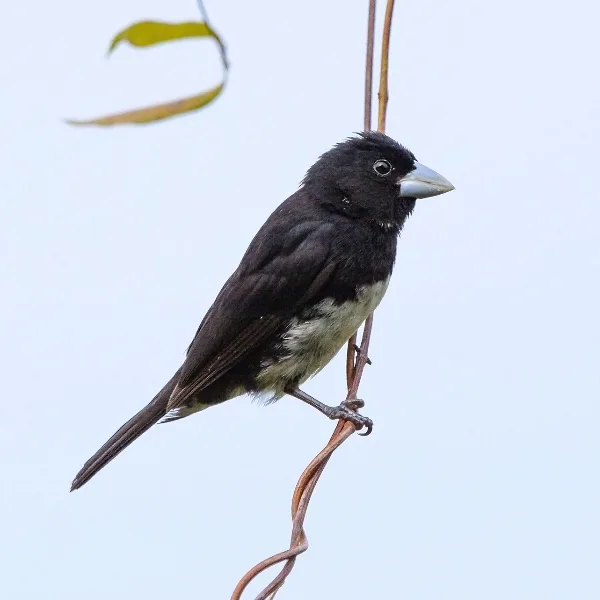
The cone-billed tanager, once thought extinct for over 60 years, was rediscovered in 2003 in Brazil’s Cerrado region. Its estimated population ranges from 250 to 990 mature individuals, with a declining trend due to habitat loss.
This species is highly dependent on gallery forests and flooded areas, which are increasingly threatened by deforestation for agriculture, particularly soy cultivation. Additionally, proposed hydroelectric projects in the Alto Juruena basin could flood key habitats, potentially impacting over half of the population.
Conservation actions include habitat protection within Emas National Park, though enforcement remains a challenge on private lands.
Raso lark (Alauda razae)
- Conservation status: Critically endangered.
- Estimated population: Between 250 and 900 mature individuals.
- Habitat and distribution: Found on the islets of Raso and Santa Luzia in Cape Verde, inhabiting arid, volcanic plains with sparse vegetation.
- Threats: Climate change, risk of invasive predators, and habitat disturbance.

The Raso lark is a critically endangered bird endemic to the Cape Verde Islands. Historically confined to the islet of Raso, conservation efforts have successfully expanded its range to Santa Luzia Island, creating a second breeding population to enhance survival prospects.
This species’ population size fluctuates with rainfall, as sufficient precipitation triggers breeding cycles. Climate change, with increased drought frequency, poses a significant risk to its reproductive success. Conservation actions have included reintroduction efforts, invasive species control, and community engagement to protect the lark’s delicate habitat.
Ridgway’s hawk (Buteo ridgwayi)
- Conservation status: Critically endangered.
- Estimated population: Around 450–520 individuals.
- Habitat and distribution: Primarily in the forests of Hispaniola, especially in the Dominican Republic.
- Threats: Habitat loss, hunting, and limited range.
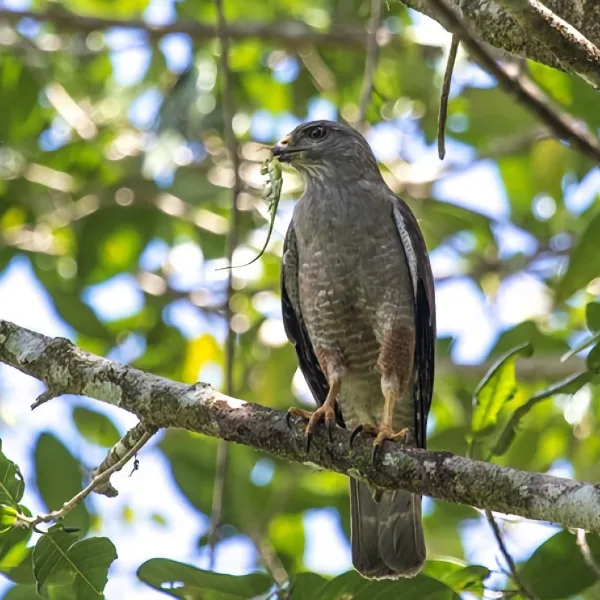
The Ridgway’s hawk, once widespread across Hispaniola, is now mainly confined to isolated areas in the Dominican Republic. Thanks to conservation efforts, the species has shown significant recovery. The number of breeding pairs in Los Haitises National Park more than doubled from 37 in 2011 to 76 in 2019. Reintroduction programs in Punta Cana have further bolstered the population, with 28 breeding pairs fledging 28 young in the recent breeding season.
These initiatives have contributed to a global population increase from around 250 individuals in 2002 to approximately 450–520 in 2025. Despite these gains, the hawk still faces risks from habitat loss and persecution, highlighting the need for continued conservation measures.
Spoon-billed sandpiper (Calidris pygmaea)
- Conservation status: Critically endangered.
- Estimated population: Approximately 440 mature individuals.
- Habitat and distribution: Breeds in northeastern Russia and migrates to Southeast Asia, wintering in areas like Bangladesh, Thailand, Myanmar, and Vietnam.
- Threats: Habitat loss, illegal trapping, and environmental changes along migratory routes.
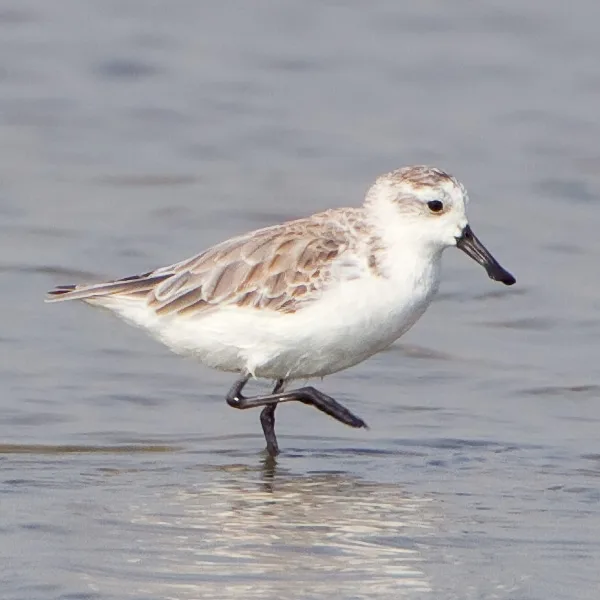
The spoon-billed sandpiper, known for its unique spoon-shaped bill, is one of the world’s most endangered shorebirds. As of 2025, the global population is estimated to be around 440 mature individuals. This species faces a high risk of extinction due to habitat loss, particularly in critical migratory stopover sites along the Yellow Sea, and illegal trapping in wintering grounds.
Conservation efforts, including habitat restoration and headstarting (raising chicks in captivity before releasing them into the wild) have helped slow the decline. Additionally, satellite tracking has recently revealed new nesting sites, offering fresh insights for future conservation strategies.
Baer’s pochard (Aythya baeri)
- Conservation status: Critically endangered.
- Estimated population: Between 150 and 700 mature individuals.
- Habitat and distribution: Wetlands in parts of eastern Asia, particularly in China.
- Threats: Draining of wetlands, hunting, and competition with other waterfowl.
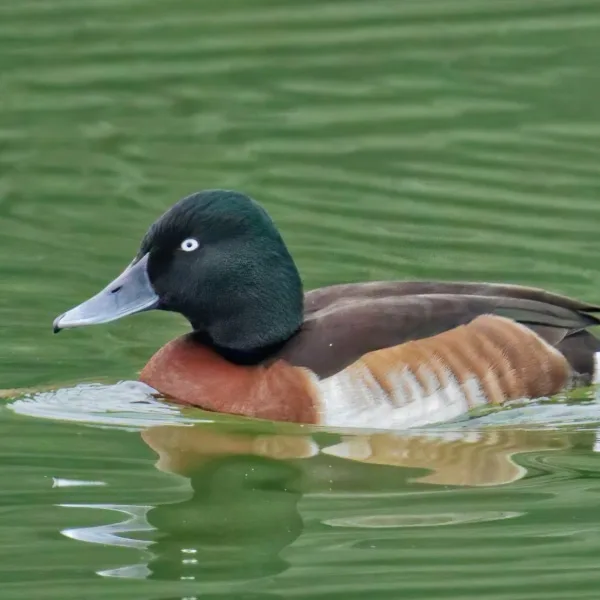
Baer’s pochard is a medium-sized diving duck once common across Asia, but its numbers have plummeted due to extensive habitat loss and hunting pressures. Over the past two decades, the population has declined dramatically, primarily because wetlands, its preferred habitat, are being drained or encroached upon by development.
Conservationists are focusing on breeding in captivity and protecting critical wetland areas to stabilize its population. Dedicated captive breeding programs are helping to bolster wild populations and support recovery efforts. While sightings are rare, dedicated wetland reserves in China and other regions offer some hope for the species’ survival.
Javan blue-banded kingfisher (Alcedo euryzona)
- Conservation status: Critically endangered.
- Estimated population: Fewer than 250 mature individuals.
- Habitat and distribution: Endemic to Java, Indonesia; inhabits lowland forests and rivers.
- Threats: Habitat loss due to deforestation, agricultural expansion, and human disturbance.
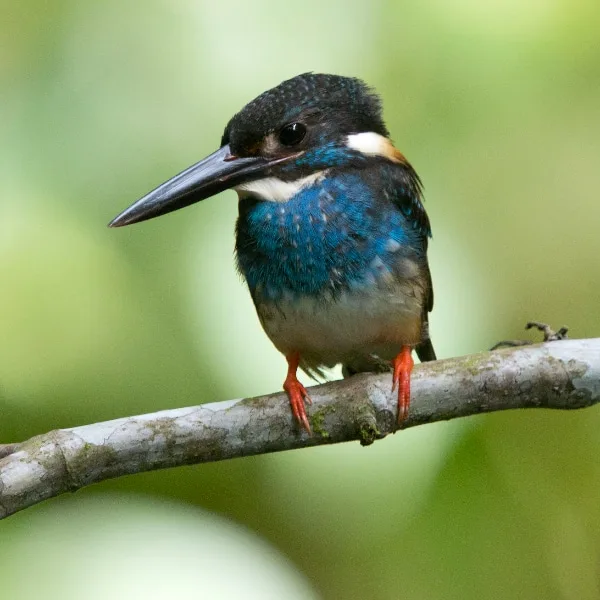
The Javan blue-banded kingfisher is a bird species endemic to the island of Java, Indonesia. This small kingfisher is characterized by its distinctive blue-green breastband and inhabits lowland forests and rivers. The population is estimated to be fewer than 250 mature individuals, with a declining trend.
Major threats include habitat loss from deforestation, agricultural expansion, and human disturbances. Conservation efforts focus on habitat protection and restoration, as well as community engagement to promote sustainable land-use practices.
Brazilian merganser (Mergus octosetaceus)
- Conservation status: Critically endangered.
- Estimated population: Fewer than 250 mature individuals.
- Habitat and distribution: Clear, fast-flowing rivers in Brazil, with a small population in Argentina.
- Threats: Habitat loss due to hydroelectric dams, pollution, and human disturbance.
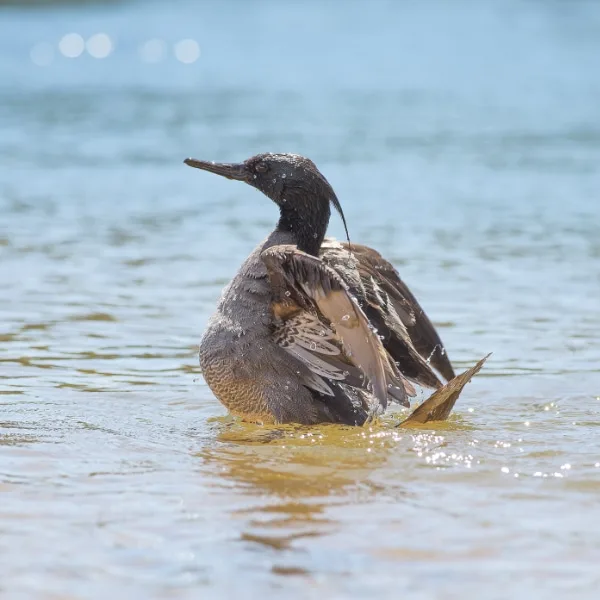
The Brazilian merganser is one of the world’s rarest ducks, primarily found in clear, fast-flowing rivers in Brazil, with an isolated population in Argentina. Its population is estimated to be fewer than 250 mature individuals, largely due to habitat fragmentation from dam construction, pollution, and river modification. The species’ narrow habitat requirements make it highly vulnerable to these changes.
Conservationists are focusing on protecting key river habitats, raising public awareness, and promoting sustainable practices to limit human impact on its ecosystem. Continuous habitat preservation efforts are critical for the survival of this unique, river-dependent species.
Kakapo (Strigops habroptilus)
- Conservation status: Critically endangered.
- Estimated population: 244 individuals as of 2025.
- Habitat and distribution: Currently found on predator-free islands and recently reintroduced to mainland New Zealand in managed sanctuaries.
- Threats: Predation by invasive species, habitat loss, disease, and low genetic diversity.
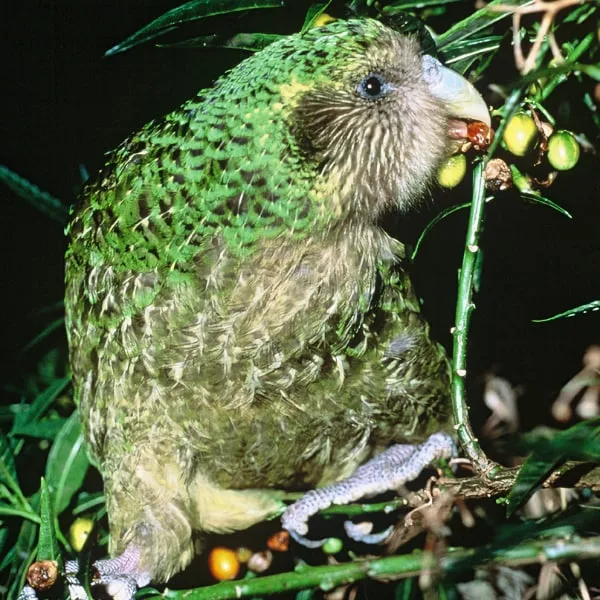
The Kakapo, also known as the owl parrot, is a nocturnal, flightless parrot native to New Zealand. Once on the brink of extinction, with only 51 individuals in 1995, intensive conservation efforts have led to a population increase to 244 individuals by 2025. These efforts include predator-free island habitats, successful breeding programs, and, recently, the historic reintroduction to Sanctuary Mountain Maungatautari on mainland New Zealand.
Advanced genomic research has also helped manage genetic diversity and address disease threats. The Kakapo’s survival story is a remarkable example of how concerted conservation actions can prevent extinction.
Mariana crow (Corvus kubaryi)
- Conservation status: Critically endangered.
- Estimated population: Fewer than 200 mature individuals, primarily on Rota Island.
- Habitat and distribution: Endemic to the Mariana Islands, with the last remaining wild population on Rota Island after extinction on Guam.
- Threats: Habitat loss, predation by invasive species (like brown tree snakes on Guam and rats and feral cats on Rota), and human disturbance.
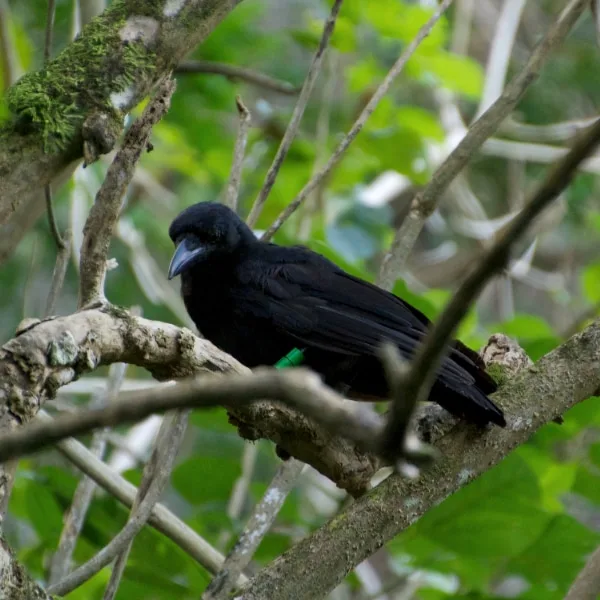
The Mariana crow is a forest-dwelling crow native to the Mariana Islands in the western Pacific Ocean. It has been extirpated from Guam due to predation by the invasive brown tree snake (Boiga irregularis) and now survives only on Rota Island. Despite its relatively small size compared to other crow species, the Mariana crow plays a crucial role in its ecosystem. However, its population has sharply declined, with fewer than 200 individuals remaining, making it one of the most endangered corvids globally.
A study from the University of Washington indicated that without significant intervention, the Mariana crow could go extinct within 75 years, nearly twice as soon as previously believed. The primary cause of decline is the low survival rate of fledglings, with only about 40% reaching their first birthday.
Conservation efforts, including predator control, habitat protection, and captive breeding programs, have shown some promise. In 2018, five captive-reared crows were successfully released into the wild, marking a hopeful step in reversing the species’ decline. However, continued efforts are essential to secure a stable future for this critically endangered bird.
Great Indian bustard (Ardeotis nigriceps)
- Conservation status: Critically endangered.
- Estimated population: Fewer than 200 individuals.
- Habitat and distribution: Arid grasslands in India, primarily in Rajasthan.
- Threats: Habitat destruction, hunting, and collisions with power lines.
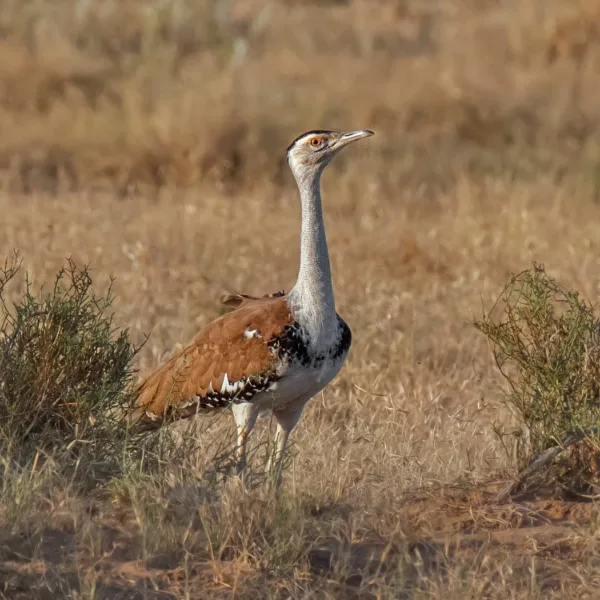
The great Indian bustard, one of the heaviest flying birds, inhabits India’s arid grasslands. Unfortunately, habitat loss from agricultural expansion and infrastructure development has left the bustard with limited suitable range. Collisions with power lines are now a leading cause of mortality for this species, and ongoing efforts are being made to install bird diverters on high-risk power lines to prevent further deaths.
Conservation initiatives also focus on habitat restoration in protected areas and creating secure breeding sites. As an iconic bird in India, the great Indian bustard is a symbol of the urgent need for grassland preservation and wildlife-friendly infrastructure.
Masafuera rayadito (Aphrastura masafuerae)
- Conservation status: Critically endangered.
- Estimated population: Between 90 and 330 mature individuals.
- Habitat and distribution: Found in dense fern forests and montane scrub on Alejandro Selkirk Island in Chile’s Juan Fernández Archipelago.
- Threats: Habitat degradation from fires, logging, and grazing, along with predation by introduced species like rats and cats.
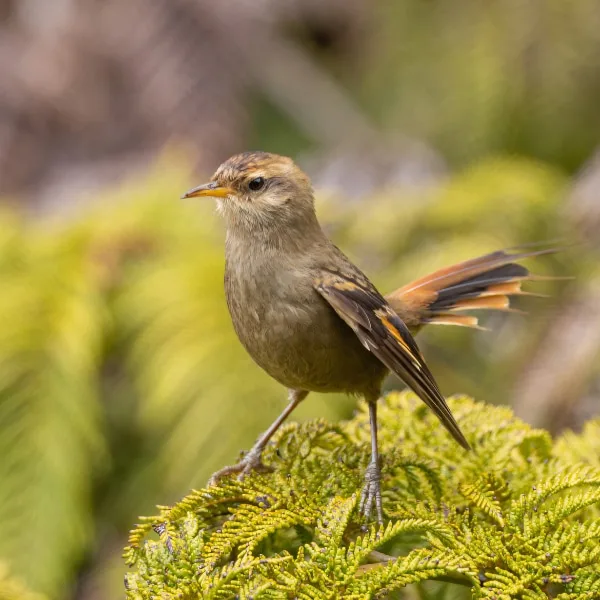
The Masafuera rayadito, a small bird with a distinctive rufous tail, is endemic to Alejandro Selkirk Island. With a population estimate between 90 and 330 mature individuals, it remains highly vulnerable due to habitat loss and fragmentation caused by historical fires, logging, and grazing by introduced goats. Predation by invasive rats and feral cats further threatens its survival.
Conservation efforts are focused on habitat restoration, predator control, and providing safe nesting sites. Recently, conservationists have installed nest boxes that exclude rodents to protect the rayadito’s nests and improve breeding success.
Negros bleeding-heart (Gallicolumba keayi)
- Conservation status: Critically endangered.
- Estimated population: Fewer than 300 mature individuals.
- Habitat and distribution: Endemic to Negros Island, Philippines, in lowland forests.
- Threats: Deforestation, hunting, and habitat fragmentation.
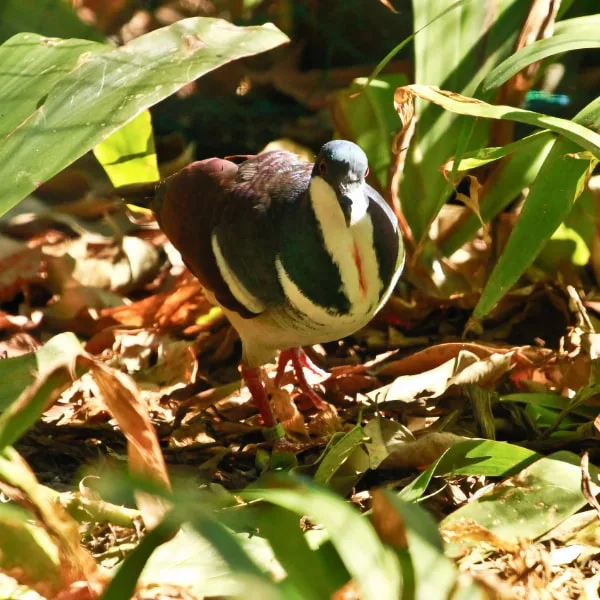
The Negros bleeding-heart is a striking ground-dwelling pigeon named for its vivid red chest marking. Once widespread on Negros Island, its population has plummeted due to extensive deforestation and illegal hunting.
The species relies on undisturbed lowland forests, making habitat loss a major threat. Despite some conservation efforts, including captive breeding and protected areas, the species remains at critical risk.
White-winged flufftail (Sarothrura ayresi)
- Conservation status: Critically Endangered.
- Estimated population: Fewer than 230 mature individuals.
- Habitat and distribution: High-altitude wetlands in Ethiopia and South Africa.
- Threats: Habitat destruction due to wetland drainage, agricultural expansion, overgrazing, and climate change.

The white-winged flufftail is one of the rarest and most elusive birds in Africa, primarily inhabiting seasonal marshlands in Ethiopia and South Africa. Until recently, its breeding grounds were unknown, but a 2018 discovery confirmed nesting in South Africa, suggesting the species may breed in both countries. With fewer than 230 mature individuals remaining, the species faces a high risk of extinction.
Conservationists have identified habitat degradation, particularly in Ethiopia’s Berga wetlands and South Africa’s high-altitude grasslands, as the primary cause of decline. Ongoing initiatives focus on wetland restoration, water management, and policy advocacy to safeguard its fragile habitat. However, due to its cryptic nature and remote habitat, significant knowledge gaps remain regarding its full distribution and ecology, making conservation efforts even more challenging.
Black stilt (Himantopus novaezelandiae)
- Conservation status: Critically endangered.
- Estimated population: Approximately 169 adults as of 2023.
- Habitat and distribution: Endemic to New Zealand, primarily in the braided rivers and wetlands of the Mackenzie Basin, South Island
- Threats: Predation by introduced mammals, habitat loss, and hybridization with the pied stilt.
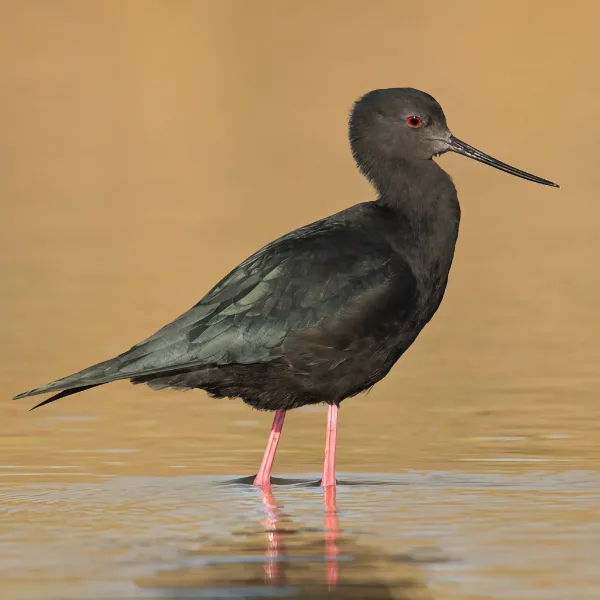
The black stilt is one of the world’s rarest wading birds, with an estimated 169 mature individuals remaining in the wild as of August 2023. This species is endemic to New Zealand, predominantly inhabiting the braided rivers and wetlands of the Mackenzie Basin in the South Island.
Major threats include predation by introduced mammals such as feral cats, ferrets, and hedgehogs, habitat loss due to hydroelectric development and agriculture, and hybridization with the more common pied stilt.
Conservation efforts have been intensive, involving captive breeding and release programs, predator control, and habitat restoration. These measures have contributed to a gradual increase in the population, yet the species remains critically endangered.
White-bellied heron (Ardea insignis)
- Conservation status: Critically endangered.
- Estimated population: Between 75 and 280 mature individuals.
- Habitat and distribution: Undisturbed rivers and wetlands in Bhutan, northeast India, and northern Myanmar.
- Threats: Habitat loss due to deforestation and hydropower dams, human disturbances, and small population size.
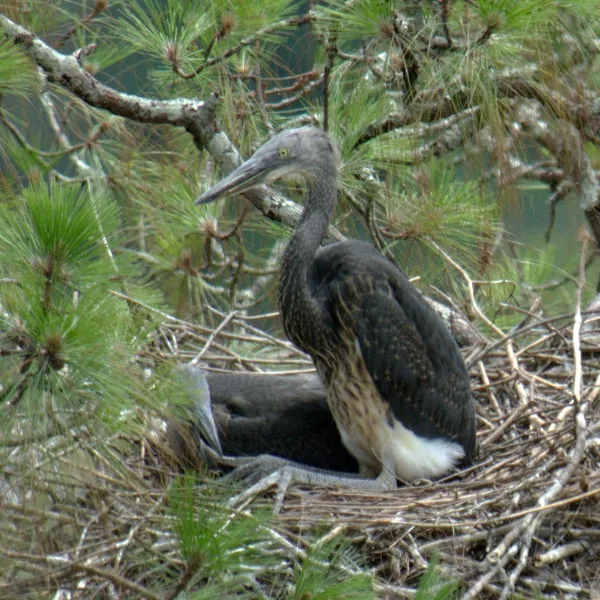
The white-bellied heron is one of the rarest herons in the world, with an estimated 75 to 280 mature individuals remaining. It inhabits forested foothills along clear rivers and wetlands in Bhutan, northeast India, and Myanmar. Major threats include habitat loss from hydropower dam construction, deforestation, and agricultural expansion. Human activities like fishing, sand mining, and infrastructure development near its nesting and foraging sites also disrupt its breeding success.
Conservation efforts focus on establishing protected habitats in Bhutan and India, engaging local communities in habitat restoration, and conducting research to monitor the population and inform conservation strategies.
Taita apalis (Apalis fuscigularis)
- Conservation status: Critically endangered.
- Estimated population: Between 50 and 250 mature individuals.
- Habitat and distribution: Found in montane forests of the Taita Hills, southeastern Kenya.
- Threats: Habitat loss from deforestation and agriculture, illegal logging, and climate change impacts.
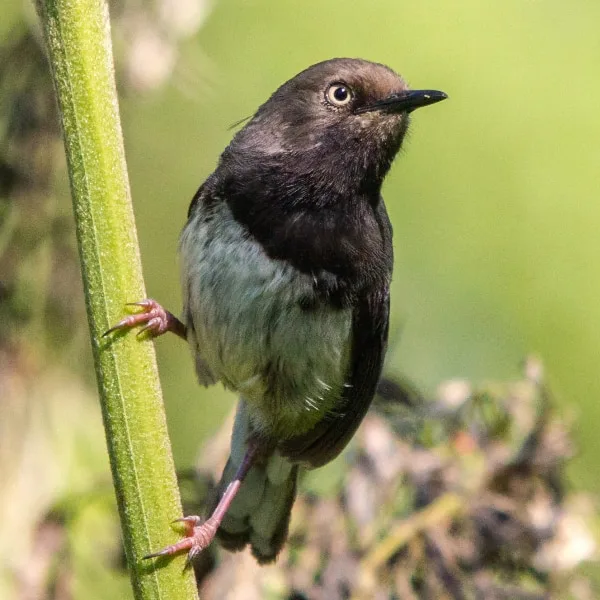
The Taita apalis, a bird endemic to Kenya’s Taita Hills, faces severe challenges with a population estimated between 50 and 250 mature individuals. It inhabits dense, fragmented forest patches, including Ngangao, Chawia, and Vuria forests, which are rapidly diminishing due to agricultural expansion, illegal logging, and climate-related changes affecting rainfall.
Conservationists are working on habitat restoration projects, including reforestation and invasive species control, to improve the quality of remaining forest areas. Community engagement initiatives encourage sustainable land use and help establish community-managed forest areas, essential to preserving this unique species’ habitat.
Polynesian ground dove (Pampusana erythroptera)
- Conservation status: Critically endangered.
- Estimated population: Between 100 and 120 mature individuals.
- Habitat and distribution: Limited to rat-free atolls within the Tuamotu Archipelago, including Tenararo, Morane, and Vahanga.
- Threats: Predation by invasive species, habitat loss, and climate change effects.

The Polynesian ground dove, or Tutururu, is a critically endangered species found only on a few remote atolls in French Polynesia’s Tuamotu Archipelago. This ground-dwelling dove prefers dense, low-lying forests with a mix of shrubs, ferns, and grasses, particularly in areas rich with Pandanus and Pisonia vegetation.
With an estimated population of 100 to 120 mature individuals, the species faces severe threats from invasive predators, like rats and cats, that prey on its eggs and chicks. Habitat loss from human activity and climate change, such as rising sea levels and increased storm frequency, also endanger these vulnerable habitats.
Conservation efforts focus on invasive species eradication, habitat restoration, and the establishment of protected areas on key atolls to secure the species’ survival.
Long-billed tailorbird (Artisornis moreaui)
- Conservation status: Critically endangered.
- Estimated population: Between 30 and 200 mature individuals.
- Habitat and distribution: Endemic to the East Usambara Mountains in Tanzania and the Njesi Plateau in northern Mozambique.
- Threats: Habitat loss due to deforestation, invasive species, and limited range.

The long-billed tailorbird, also known as the long-billed forest warbler, is a bird species with an estimated population of 30 to 200 mature individuals. It inhabits the East Usambara Mountains in Tanzania and the Njesi Plateau in northern Mozambique. This elusive bird prefers submontane and montane forests, particularly areas with dense undergrowth and proximity to streams.
Major threats include habitat loss from deforestation, the spread of invasive plant species like Maesopsis eminii, and its limited distribution. Conservation efforts focus on habitat restoration, invasive species control, and community engagement to promote sustainable land-use practices.
Antioquia brushfinch (Atlapetes blancae)
- Conservation status: Critically Endangered.
- Estimated population: Up to 405 individuals, but mature population remains low.
- Habitat and distribution: Endemic to Colombia; inhabits montane shrubland and forest edges in the northern Andes.
- Threats: Habitat loss due to deforestation, agricultural expansion, and habitat fragmentation.
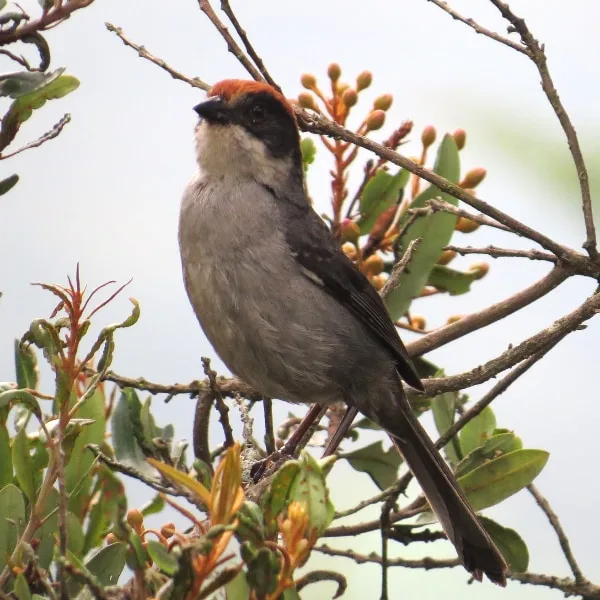
Once feared extinct, the Antioquia brushfinch was rediscovered in 2018 near San Pedro de los Milagros, Colombia. Initial surveys identified fewer than 20 individuals, but more recent research has expanded the known range to seven sites, with an estimated total population of up to 405 individuals. However, the number of mature individuals remains critically low, and its habitat continues to shrink due to deforestation and agricultural expansion. The species’ survival depends on urgent habitat protection and conservation efforts to prevent further decline.
Gurney’s pitta (Hydrornis gurneyi)
- Conservation status: Critically endangered.
- Estimated population: Fewer than 50 individuals.
- Habitat and distribution: Endemic to lowland forests in southern Myanmar.
- Threats: Habitat loss due to deforestation, agricultural expansion, and infrastructure development.
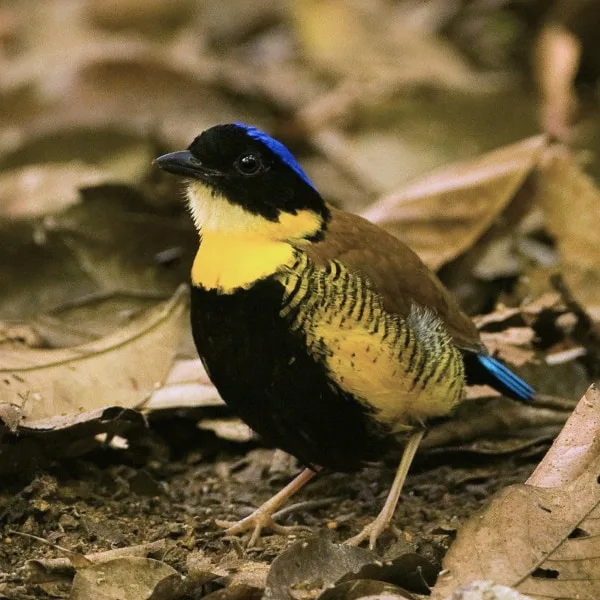
Gurney’s pitta is a critically endangered bird species once thought extinct until its rediscovery in the 1980s. Endemic to the lowland forests of southern Myanmar, this species prefers dense, moist forest habitats. The population has suffered a dramatic decline, with fewer than 50 individuals remaining. Major threats include extensive habitat loss from deforestation for agriculture, logging, and infrastructure development.
Conservation efforts focus on habitat protection and restoration, including the establishment of protected areas and community-based forest management initiatives. Ongoing research and monitoring are essential to inform conservation strategies and ensure the survival of this elusive species.
New Caledonian owlet-nightjar (Aegotheles savesi)
- Conservation status: Critically endangered.
- Estimated population: Fewer than 50 mature individuals.
- Habitat and distribution: Dense, humid forests of New Caledonia, often in areas dominated by Melaleuca vegetation.
- Threats: Habitat loss from deforestation, logging, mining, and predation by introduced species.
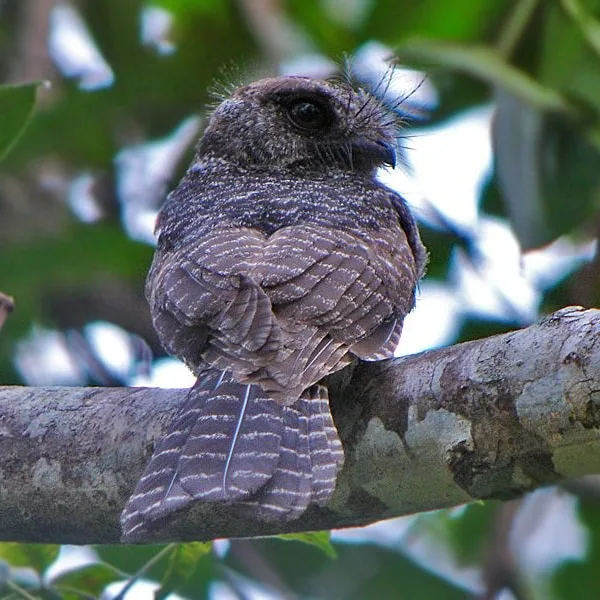
The New Caledonian owlet-nightjar is one of the world’s most ec and critically endangered birds, with fewer than 50 mature individuals thought to exist. Endemic to New Caledonia, this species relies on dense forested habitats, making it especially vulnerable to habitat loss due to agriculture, logging, and mining activities. Introduced predators, including rats and cats, further threaten its survival by preying on eggs and adult birds.
Conservation efforts focus on habitat restoration and predator control to mitigate these risks and secure a future for this rare nightjar.
Sulu hornbill (Anthracoceros montani)
- Conservation status: Critically endangered.
- Estimated population: Fewer than 50 mature individuals.
- Habitat and distribution: Endemic to the Sulu Archipelago, primarily on Tawi-Tawi Island in the Philippines.
- Threats: Severe habitat loss from deforestation, hunting, and limited range.
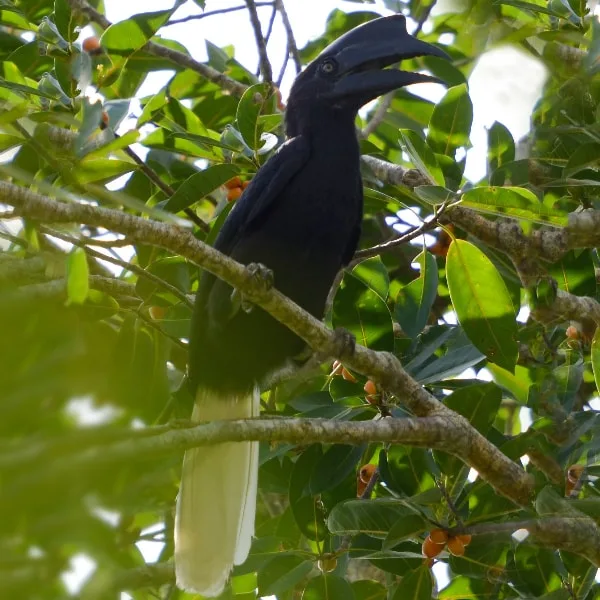
The Sulu hornbill, also known as Montano’s hornbill, is one of the most endangered hornbills in the world. With an estimated population of fewer than 50 mature individuals, it is restricted to small areas of Tawi-Tawi Island in the Sulu Archipelago.
The species depends on primary dipterocarp forests, where it relies on large trees for nesting and a diet of fruit, insects, and small lizards. Deforestation due to logging and slash-and-burn agriculture has significantly reduced its habitat. Hunting pressures have also contributed to its decline, leading to local extinctions on other islands in the archipelago.
Conservation efforts include habitat restoration on Tawi-Tawi and engaging local communities to reduce hunting pressures and promote sustainable land use.
Stresemann’s bristlefront (Merulaxis stresemanni)
- Conservation status: Critically endangered.
- Estimated population: Fewer than 50 mature individuals.
- Habitat and distribution: Endemic to the Atlantic Forest of Brazil, primarily in the states of Bahia and Minas Gerais.
- Threats: Severe habitat loss due to deforestation, fires, and habitat degradation.
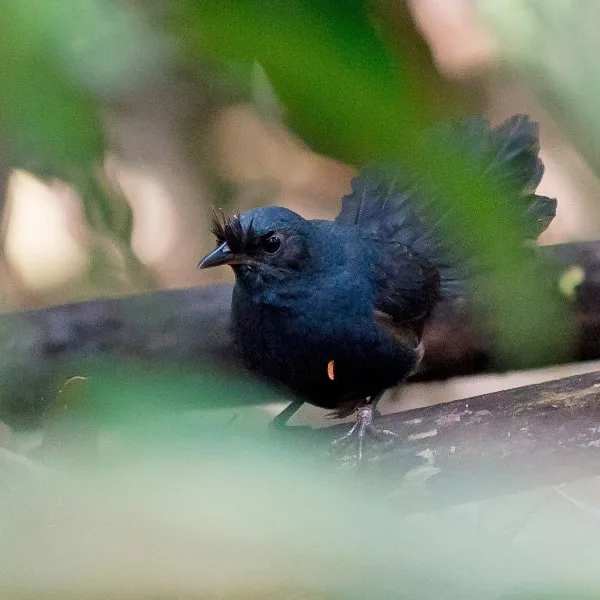
Stresemann’s bristlefront is one of the world’s rarest birds, with an estimated population of fewer than 50 mature individuals. This elusive species inhabits the rapidly diminishing Atlantic Forest in Brazil, favoring humid lowland forests with dense undergrowth. Major threats include extensive deforestation for agriculture and cattle ranching, as well as habitat degradation from logging and fires.
Conservation efforts are focused on habitat protection and restoration, notably through the establishment and expansion of the Mata do Passarinho Reserve. Engaging local communities in conservation activities and conducting ongoing research are also crucial to the species’ survival.
Jerdon’s courser (Rhinoptilus bitorquatus)
- Conservation status: Critically endangered.
- Estimated population: Fewer than 250 individuals (possibly much lower).
- Habitat and distribution: Scrub forest and dry riverbeds in Andhra Pradesh, India.
- Threats: Habitat destruction due to agriculture, infrastructure projects, and deforestation.
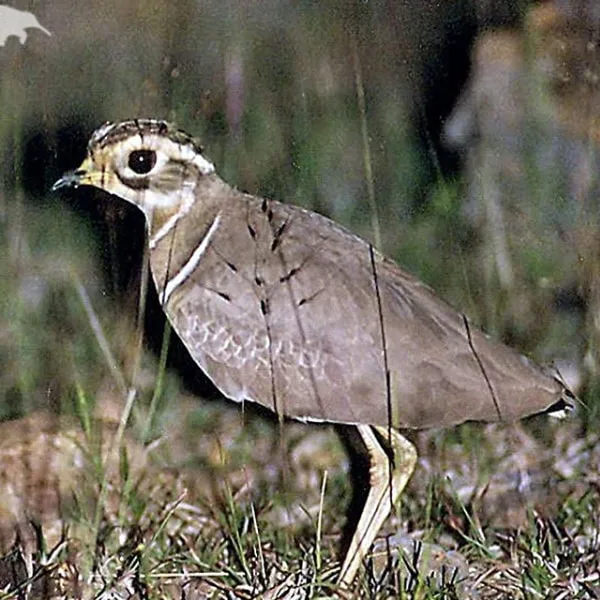
Jerdon’s courser is a nocturnal bird native to India, long thought extinct until its rediscovery in 1986. This elusive species is incredibly difficult to detect due to its secretive behavior and preference for dry scrubland. The population is estimated at fewer than 250 individuals, though recent surveys have struggled to confirm its presence.
Major threats include habitat fragmentation from agricultural expansion and infrastructure development. Conservation efforts focus on habitat protection and research to locate remaining populations.
Imperial amazon (Amazona imperialis)
- Conservation status: Critically endangered.
- Estimated population: Around 50 mature individuals.
- Habitat and distribution: Endemic to Dominica, primarily in montane forests.
- Threats: Hurricanes, deforestation, and habitat degradation.
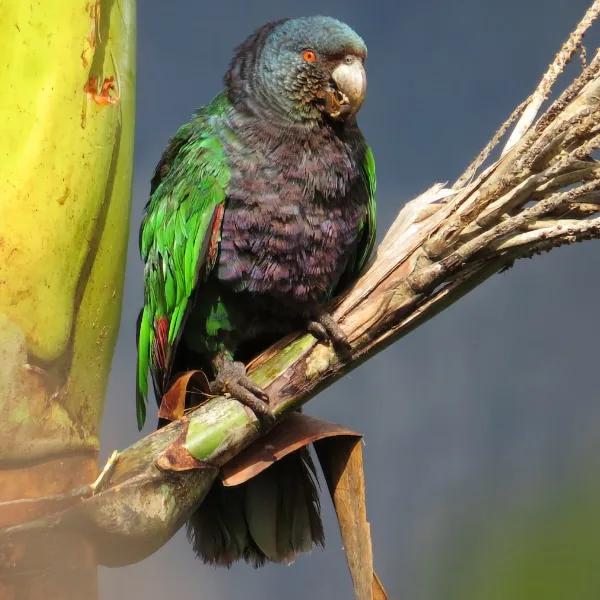
The imperial amazon, also known as the sisserou parrot, is Dominica’s national bird and one of the rarest parrots in the world. This vibrant green and purple parrot is found only in Dominica’s mountain forests. Once more abundant, its population has been severely impacted by hurricanes, particularly Hurricane Maria in 2017, which decimated much of its remaining habitat.
Conservation efforts include captive breeding and habitat restoration, but the species remains critically endangered.
Pohnpei starling (Aplonis pelzelni)
- Conservation status: Critically endangered.
- Estimated population: Fewer than 50 mature individuals.
- Habitat and distribution: Endemic to the island of Pohnpei in the Federated States of Micronesia.
- Threats: Habitat loss, predation by introduced species, and hunting.
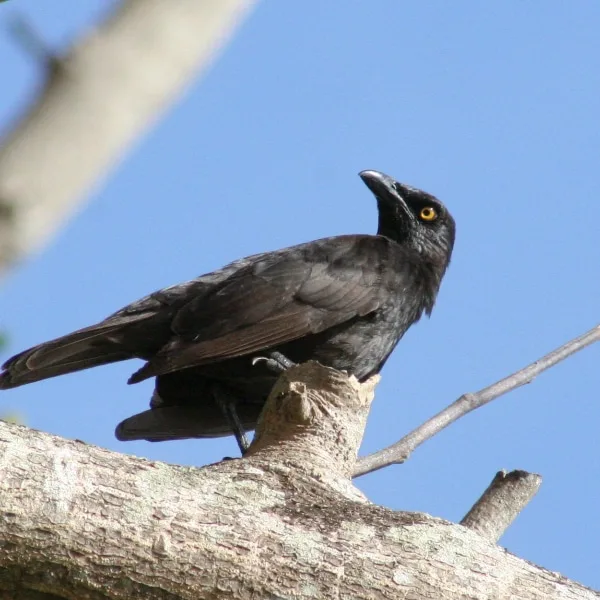
The Pohnpei starling, also known as the Pohnpei mountain starling, is a bird species endemic to the island of Pohnpei in the Federated States of Micronesia. This elusive bird inhabits dark, damp mountain forests, typically at elevations above 425 meters.
The species has experienced a dramatic decline, with the last confirmed sighting in 1995. Major threats include habitat loss due to deforestation, predation by introduced species such as rats, and hunting pressures.
Conservation efforts are hindered by the lack of recent sightings, making it challenging to implement targeted actions. Protecting remaining forest habitats and controlling invasive species are crucial steps needed to prevent the extinction of this unique bird.
Santa Marta sabrewing (Campylopterus phainopeplus)
- Conservation status: Critically endangered.
- Estimated population: Fewer than 40 mature individuals.
- Habitat and distribution: Endemic to the Santa Marta Mountains, Colombia.
- Threats: Habitat destruction and climate change.
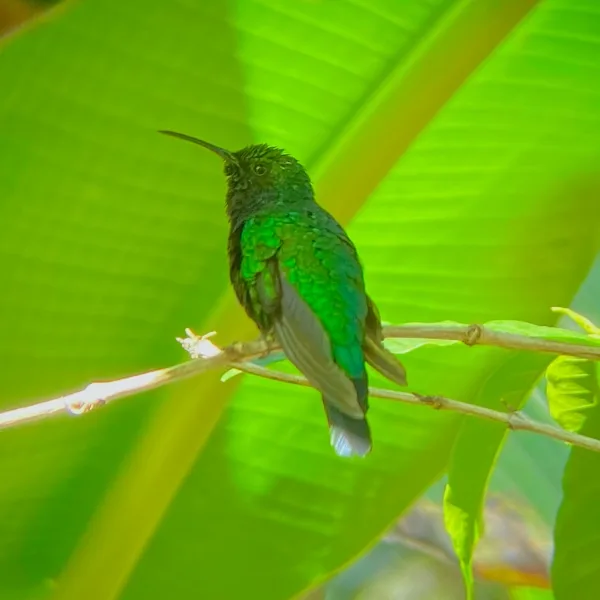
The Santa Marta sabrewing is a rare and elusive hummingbird native to the isolated Santa Marta mountain range in Colombia. After being lost to science for nearly 80 years, it was rediscovered in 2010 and again in 2022. This species relies on humid montane forests, which are rapidly being cleared for agriculture.
With very few confirmed individuals, urgent conservation efforts are needed to prevent its extinction.
Blue-eyed ground dove (Columbina cyanopis)
- Conservation status: Critically endangered.
- Estimated population: Approximately 15 individuals in the wild.
- Habitat and distribution: Found in the Cerrado region of Brazil, primarily in open savannah and grasslands.
- Threats: Habitat loss from agricultural expansion, fires, and climate change.
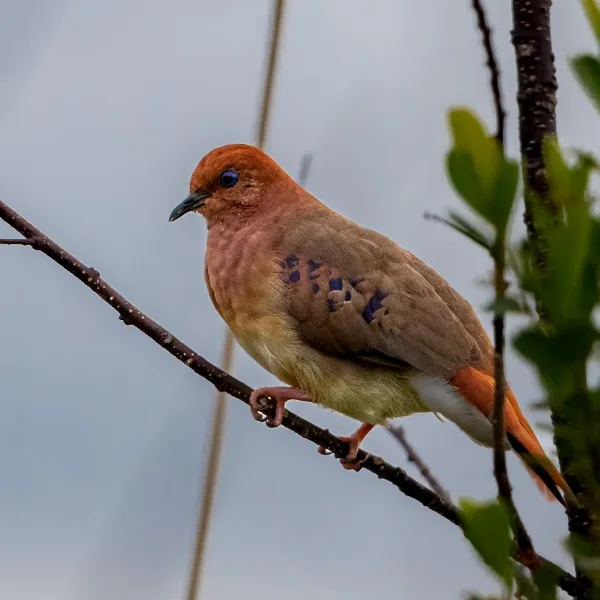
The Blue-eyed ground dove, once presumed extinct, was rediscovered in 2015 in Brazil’s Cerrado region. With an estimated wild population of around 15 individuals, it is one of the rarest birds in the world.
Conservationists have made strides in protecting its remaining habitat and establishing captive breeding programs, with recent successes in hand-rearing chicks to help secure an insurance population. Efforts to establish protected reserves and prevent habitat loss are ongoing to prevent further decline, while captive breeding provides hope for future reintroduction.
Spix’s macaw (Cyanopsitta spixii)
- Conservation status: Extinct in the wild (reintroduction underway).
- Estimated population: Around 200 individuals in captivity, with reintroduced populations now being monitored in the wild.
- Habitat and distribution: Native to the Caatinga habitat in Brazil, with recent reintroduction efforts in the region.
- Threats: Habitat loss, illegal trapping, and limited genetic diversity.
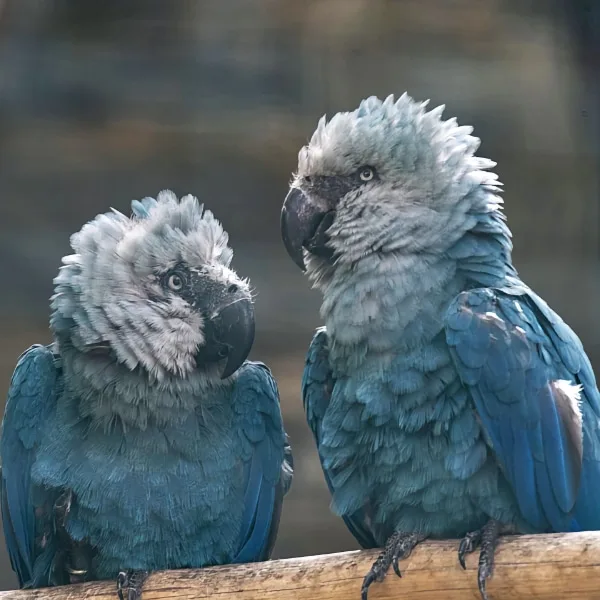
Spix’s Macaw, famously known from the animated film Rio, was declared extinct in the wild for over two decades due to illegal trapping and deforestation. However, thanks to global conservation efforts and captive breeding programs, around 200 individuals now exist in captivity, and reintroduction initiatives have brought some back to the wild.
In recent years, several captive-bred macaws were released into protected areas of the Caatinga habitat in Brazil, where they are closely monitored for adaptation. These efforts aim to establish a self-sustaining population in their native habitat, offering hope for the species’ return to the wild.
Have you seen one?
For nearly 20 years, we at Planet of Birds have been documenting the world’s rarest birds, tracking their stories of survival and decline. These bird species are a testament to nature’s resilience, but also a call to action. By protecting their habitats and reducing human impact, we can help ensure they remain in the wild for future generations.
Have you been lucky enough to see any of these rare birds? Share your experiences in the comments – we’d love to hear your stories!
